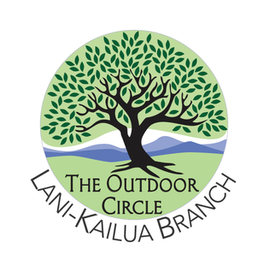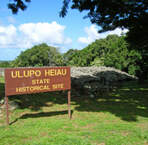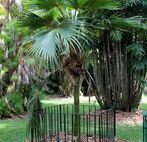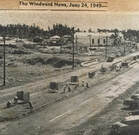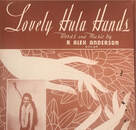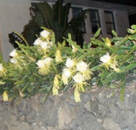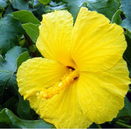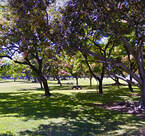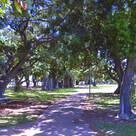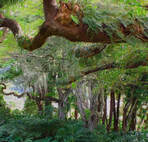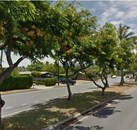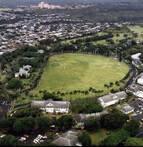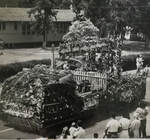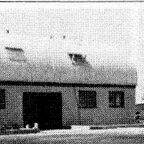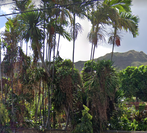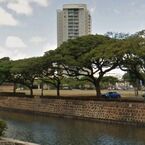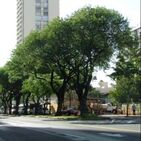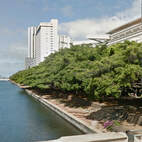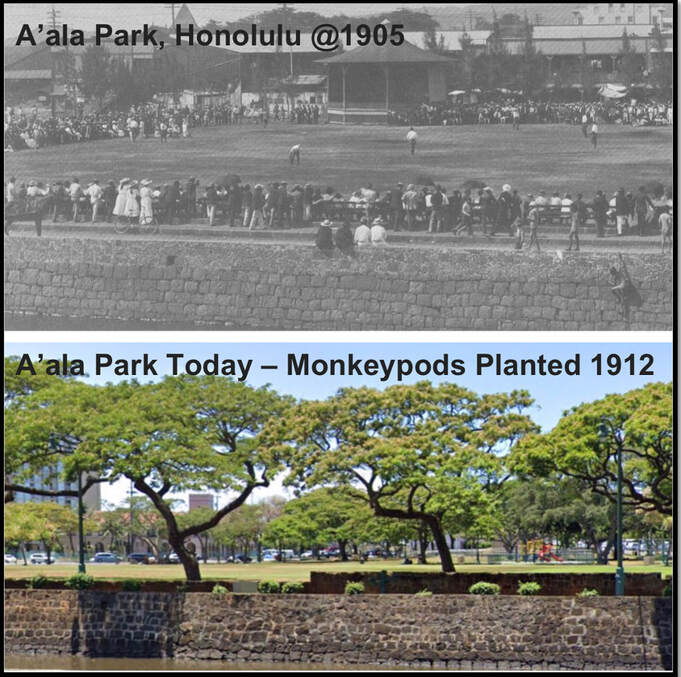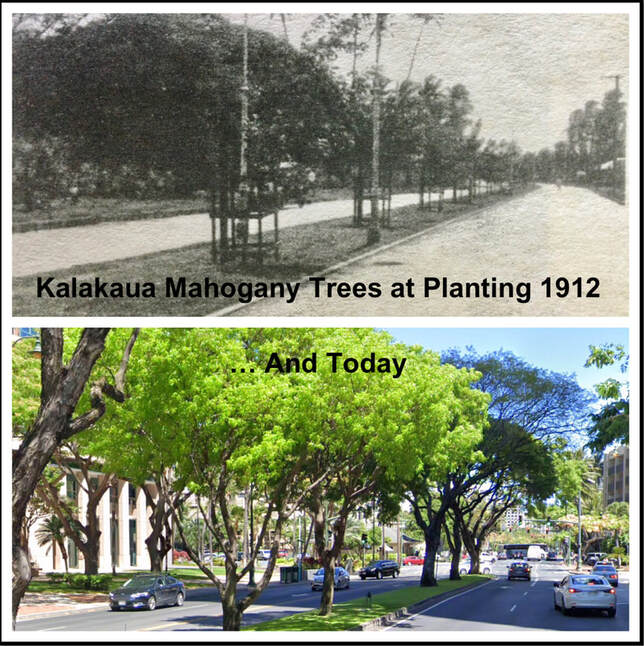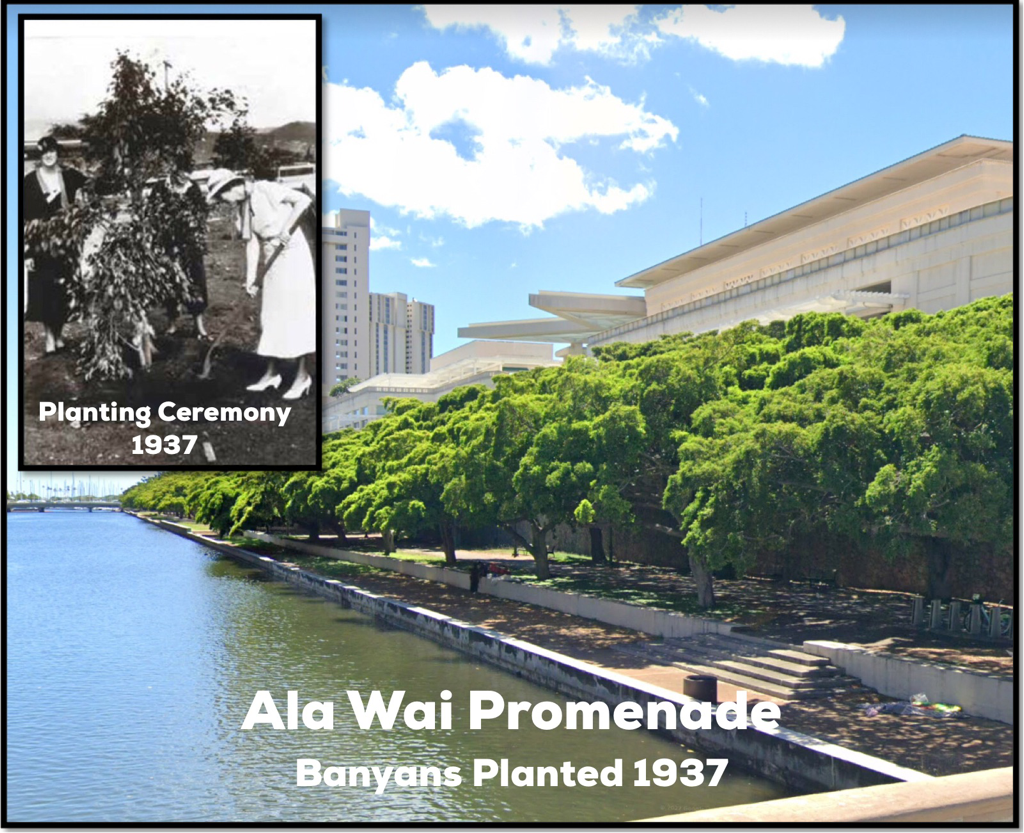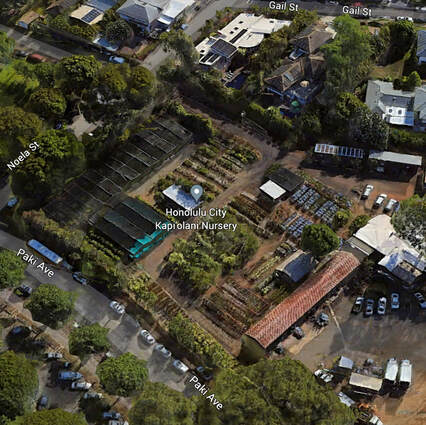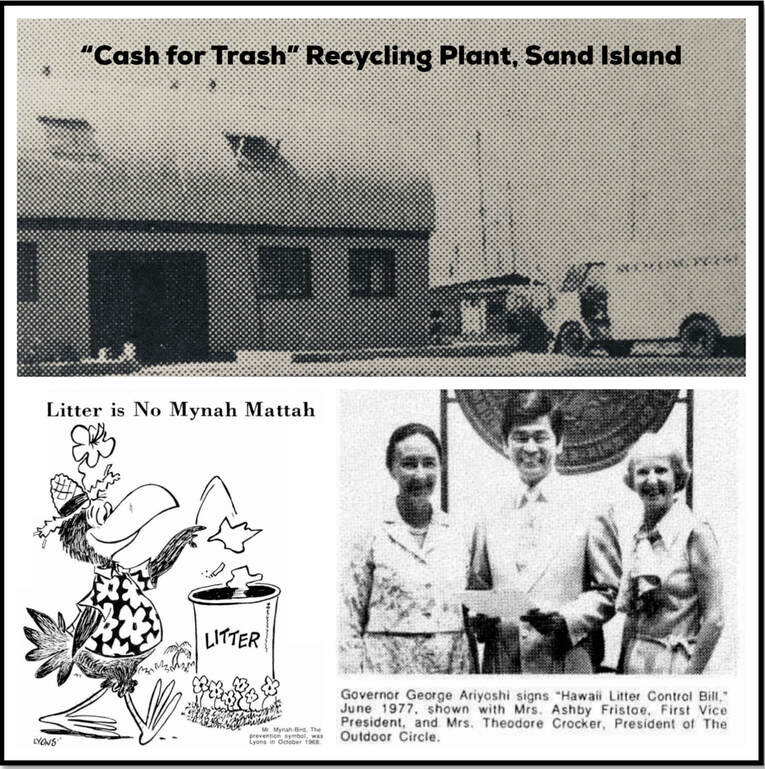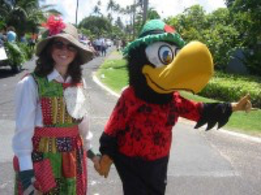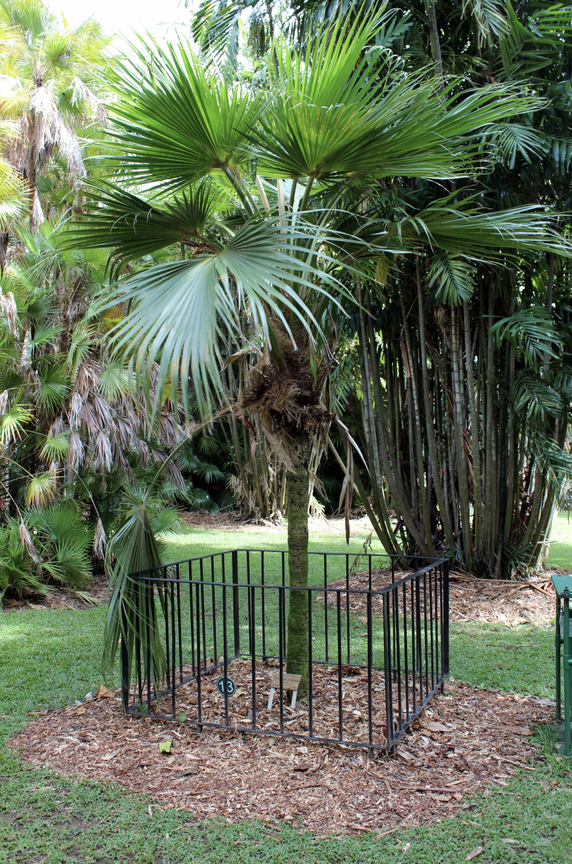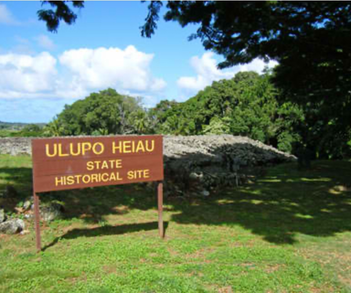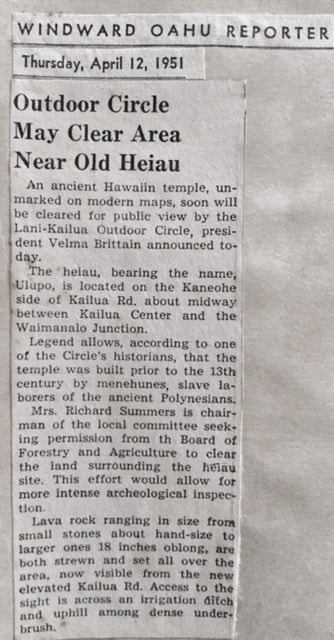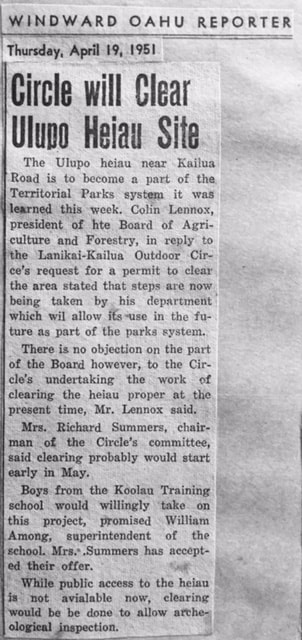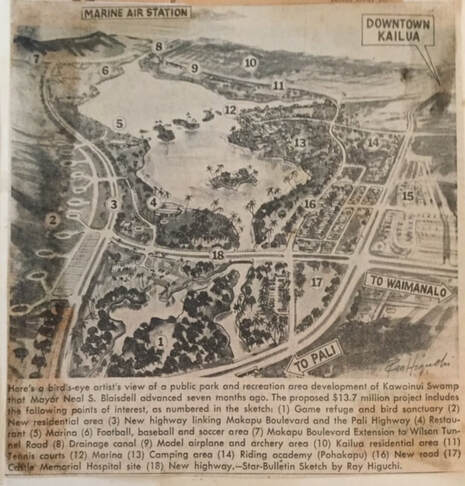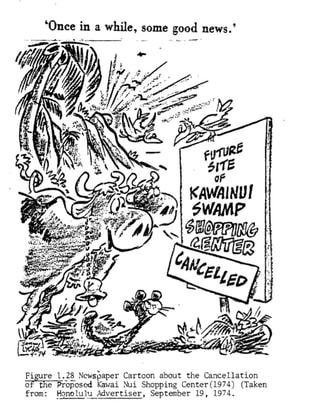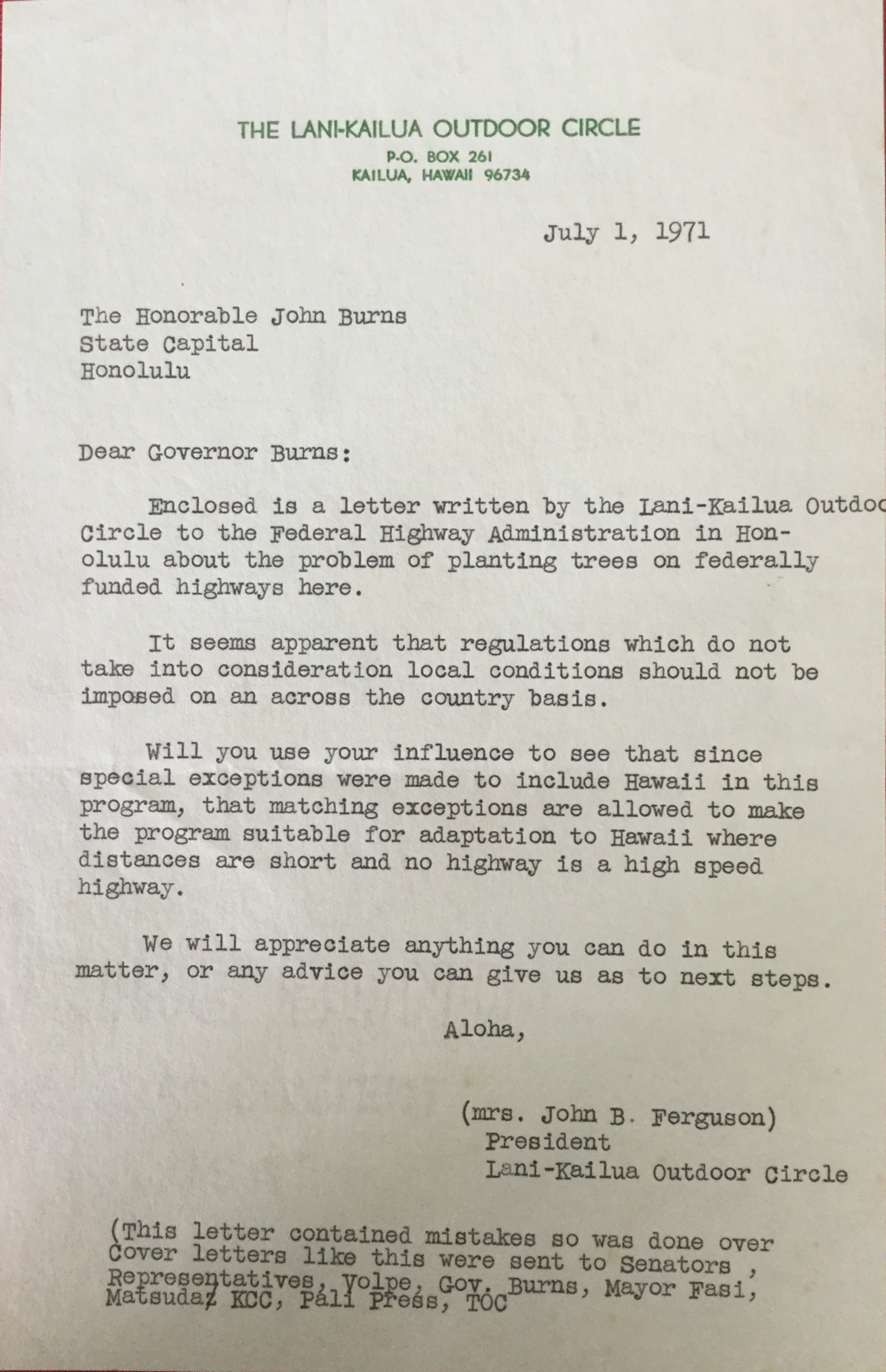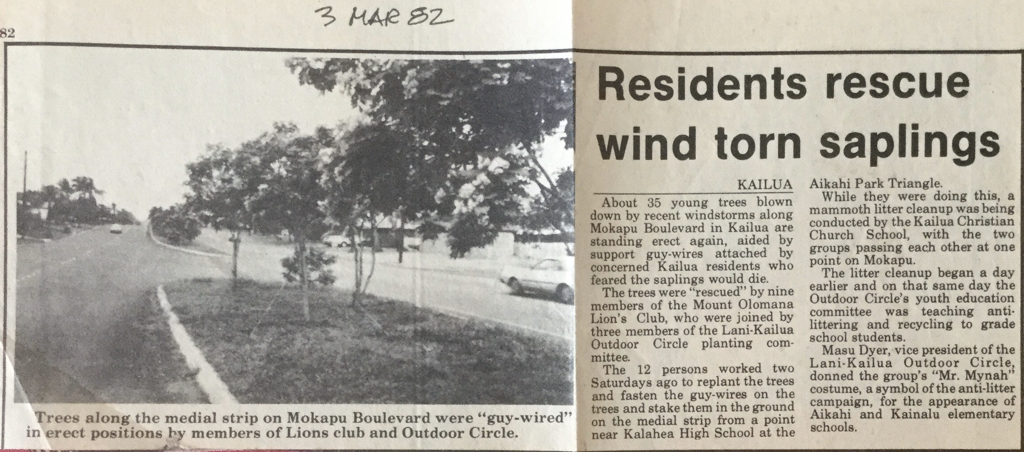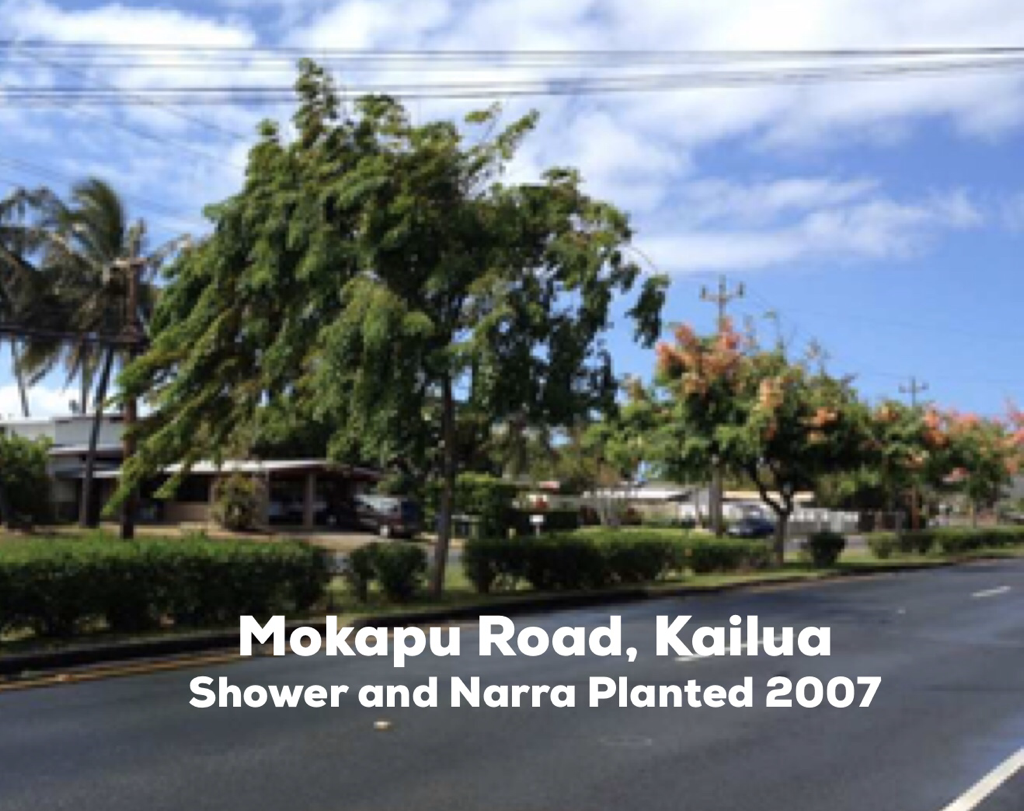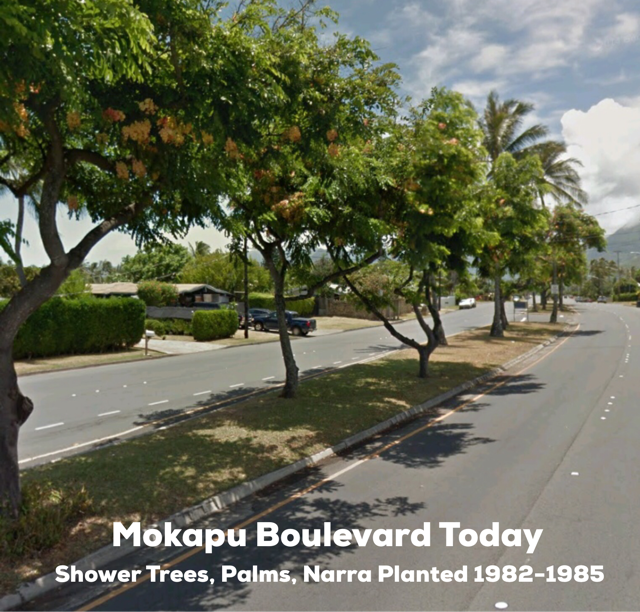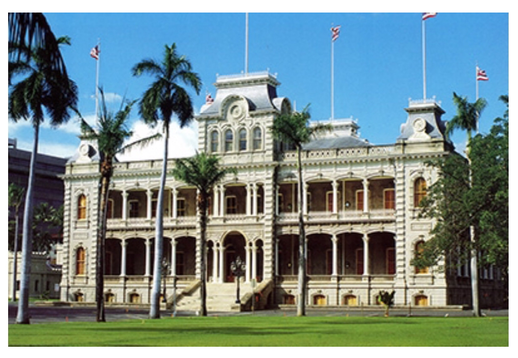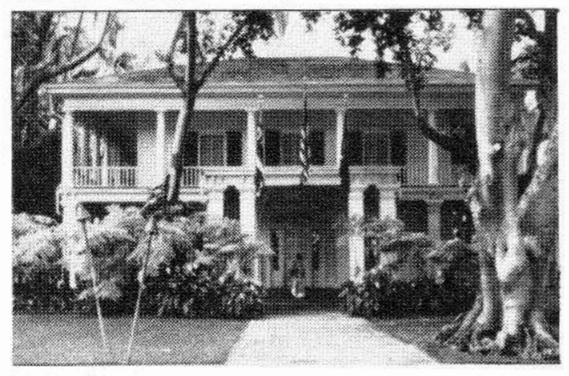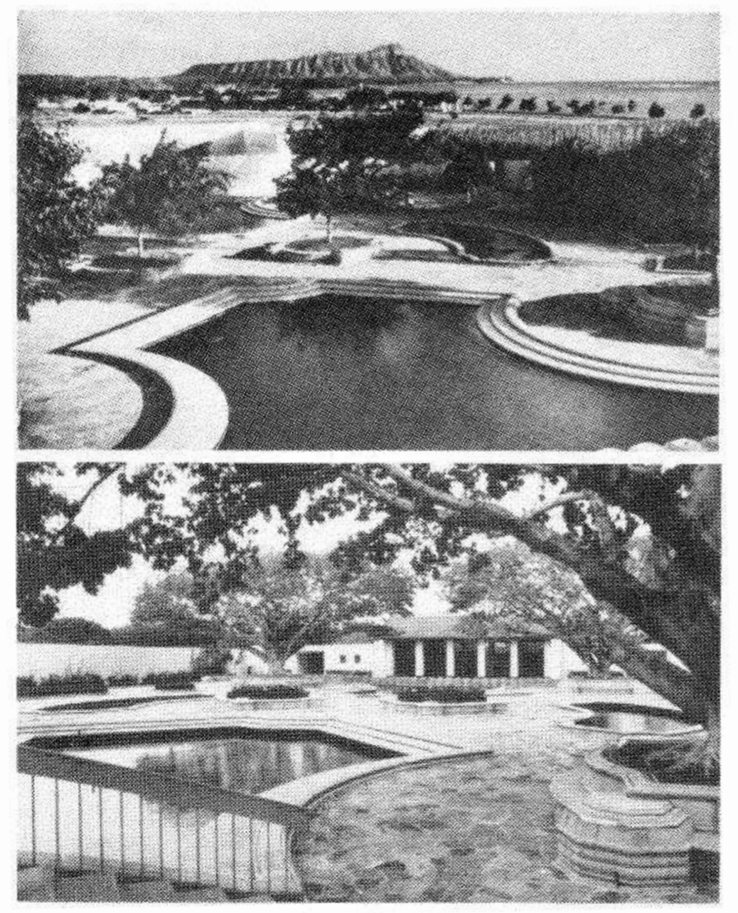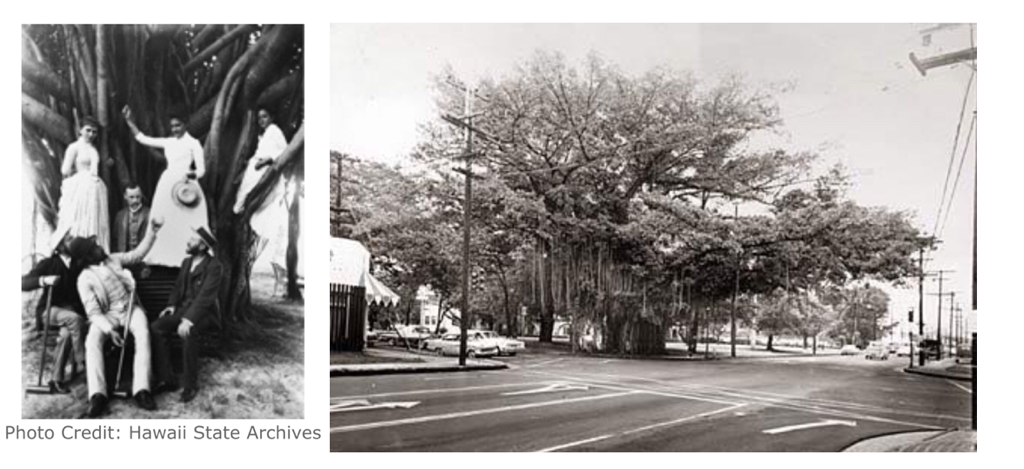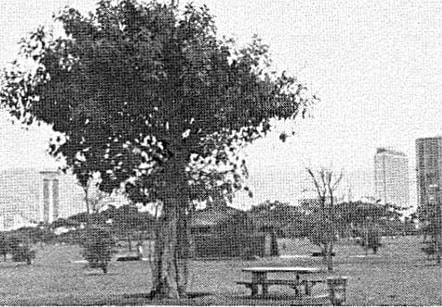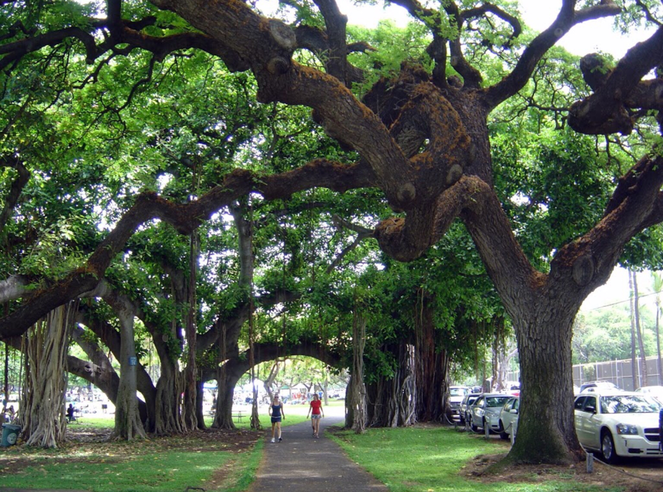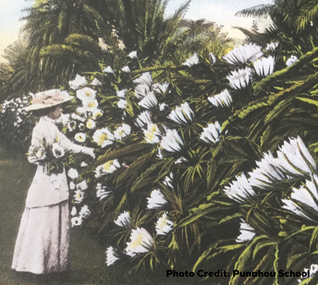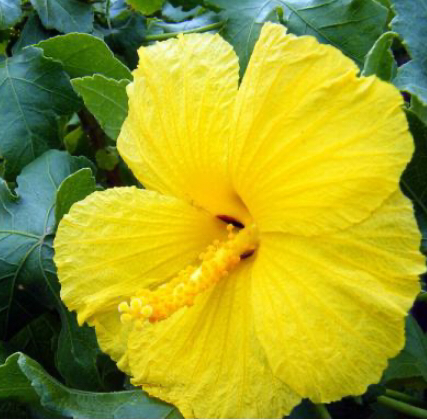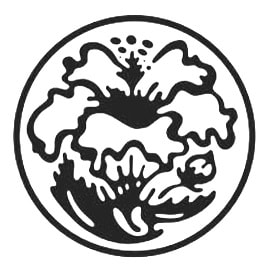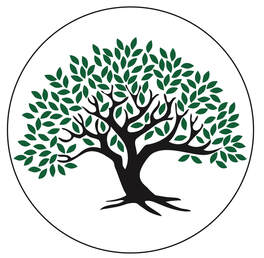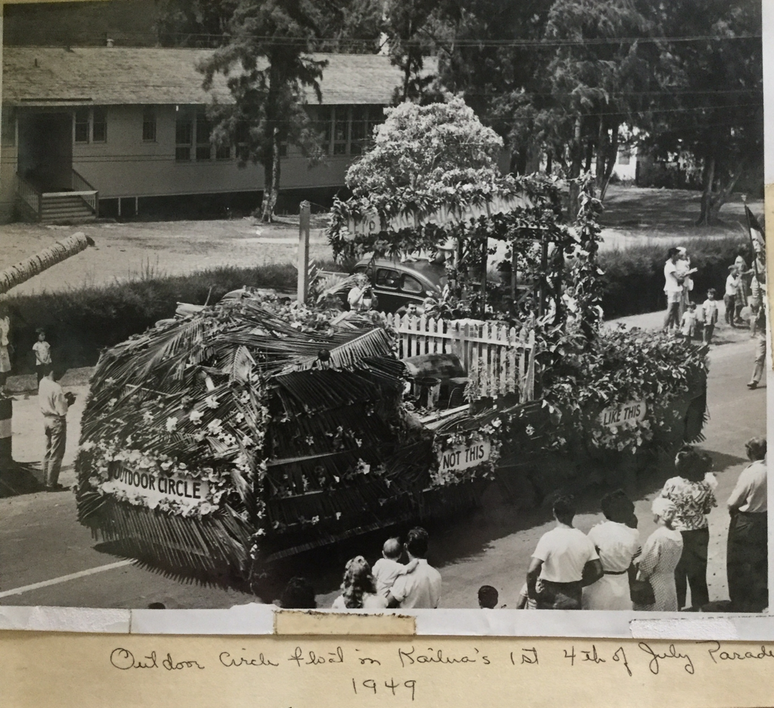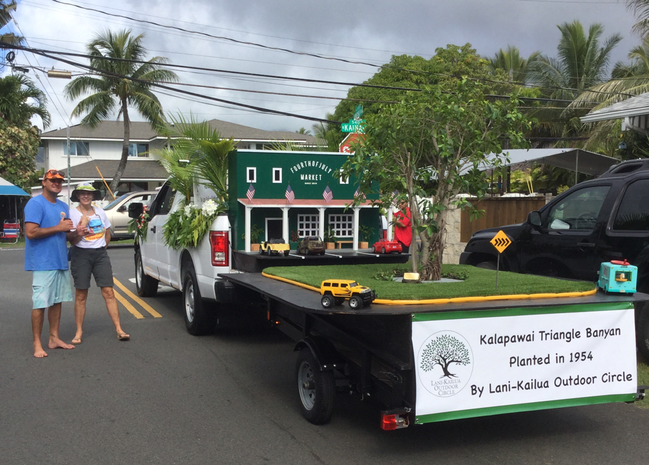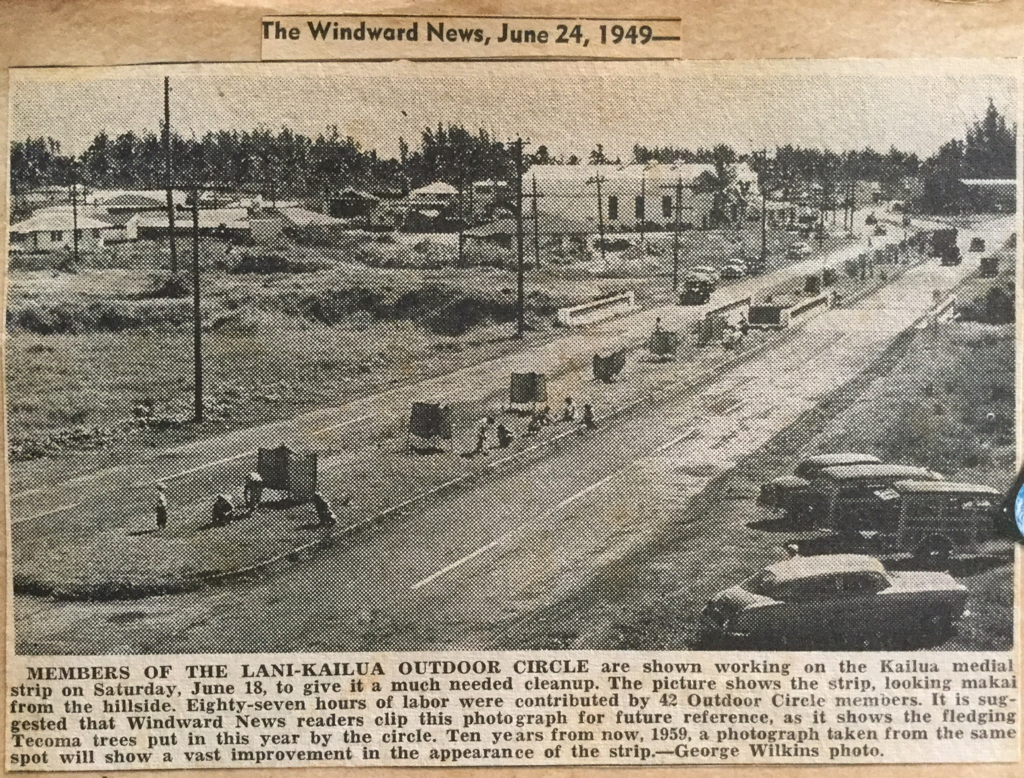A Glimpse Into Our Storied Past
On this page, you will find interesting little-known historical facts about
The Outdoor Circle and our Lani-Kailua Branch.
Click on the images below to see a glimpse of this fascinating history.
ENJOY!
**** For a more detailed history of the remarkable accomplishments of the Outdoor Circle, click <HERE>****
Did you know … that in 1912, the Outdoor Circle
planted the beautiful monkeypod trees that shade A’ala Park today?
planted the beautiful monkeypod trees that shade A’ala Park today?
The park, one of the oldest in Hawaii, was originally named “River Park” and is bordered by Nu’uanu Stream. By the early 1900s it featured a bandstand and two baseball diamonds and baseball became the park’s defining image (see top photo, credit: ImagesofOldHawaii).
In 1912, as its first project, Honolulu’s newly-formed Outdoor Circle undertook the planting of twenty-two monkeypod trees “to shade the children’s play space.” The magnificent trees at A’ala Park stand today as a testament to the lasting efforts of the Outdoor Circle.
In 1912, as its first project, Honolulu’s newly-formed Outdoor Circle undertook the planting of twenty-two monkeypod trees “to shade the children’s play space.” The magnificent trees at A’ala Park stand today as a testament to the lasting efforts of the Outdoor Circle.
Did you know that in 1912, the Outdoor Circle
planted the scores of magnificent mahogany trees
along Kalakaua Avenue leading into Waikiki?
planted the scores of magnificent mahogany trees
along Kalakaua Avenue leading into Waikiki?
The stately mahogany trees in the median on Kalakaua Avenue between South Beretania Street and Ena Road are representative of just one of the many tree planting projects to beautify Honolulu undertaken by the Outdoor Circle at the time. In their continuing efforts over the years, they have replaced several that failed and added others. These trees (over 40 in number) are on the state’s Exceptional Tree Registry and stand as an enduring testament to the work of the Outdoor Circle. Pictured here are the trees at planting in 1912 (top) and how they look today (bottom) at 110 years old!
Did you know that in 1937, the Outdoor Circle
planted the magnificent banyan trees that grace the Ala Wai Promenade today?
planted the magnificent banyan trees that grace the Ala Wai Promenade today?
Over the years, the Outdoor Circle has fought to protect these trees, in particular saving many of them slated for removal when the Hawaii Convention Center was being built behind them in the late 1990s. The 58 spectacular banyans forming a beautiful double-row colonnade along this promenade are now on the state’s Exceptional Tree Registry and are a testament to the enduring efforts of The Outdoor Circle to enhance and preserve our urban tree-scape. Pictured in the inset photo of the first tree being planted in 1937 are Outdoor Circle leaders Mrs.Theo Cooke, Mrs. Cyril Damon and Mrs. Grace Wilder.
Did you know that in 1920 The Outdoor Circle
helped establish Honolulu's first City & County Plant Nursery?
helped establish Honolulu's first City & County Plant Nursery?
By 1918, the Outdoor Circle was diligently planting street trees throughout Honolulu, and requests for plants became so numerous that it was necessary for them to establish and maintain a large plant nursery with a full-time attendant. It was soon moved from Kalakaua Avenue to Paki Avenue. Thousands of plants were distributed from the nursery for highways, school grounds, military installations, cemeteries and other public planting projects, and for camouflage during World War II.
Incidentally, the nursery attendant, Mr. Olivera, who worked there for 28 years, was Honolulu’s first tree-trimmer, hired by the Outdoor Circle in 1915 to trim public trees on our streets and in our parks. He became so expert that the Electric and Telephone Companies shared his services!
Amusing anecdotes exist regarding Outdoor Circle volunteers and their attempts to see that trees were properly maintained back in those days. In one incident, as reported in notes at the time, volunteers told of meeting resistance of men from the Harbor Commission in getting fronds removed from the coconut trees the Outdoor Circle had planted. “The man in charge refuses to take off all the leaves, saying the trees will grow better with them there… As he is armed with a gun, Mrs. Von Hamm cannot insist on carrying out her wishes.”
The Outdoor Circle maintained the nursery near Kapiolani Park for decades until 1946, when it was turned over to the City Parks Board, and it remains there today as the Honolulu City Kapiolani Nursery on Paki Avenue, which also houses the city's Division of Urban Forestry offices.
The Outdoor Circle continues to work with the Department of Parks and Recreation and the Division of Urban Forestry to help keep our streets and parks landscaped and treed.
In the 1950s, The Outdoor Circle started a statewide anti-litter campaign, with a yearly “Cleanup Day” to rid neighborhoods of unsightly garbage conditions. They sponsored an anti-litter poster campaign for intermediate and high school students, with wide participation and yearly award winners. This culminated in the Outdoor Circle establishing the first recycling plant on Oahu, on Sand Island in 1967, as well as the establishment of a mascot for the program, Mr. Mynah, created by noted local political cartoonist Harry Lyons.
The recycling program, called “Cash for Trash”, had six pickup sites on Oahu and Branches on Kauai and Maui. In 1977, due to diligent efforts of the Outdoor Circle, Governor George Ariyoshi signed the “Hawaii Litter Control Bill” to plan, coordinate, and implement litter control efforts. These provisions are still in force in the Hawaii Revised Statutes.
The recycling program, called “Cash for Trash”, had six pickup sites on Oahu and Branches on Kauai and Maui. In 1977, due to diligent efforts of the Outdoor Circle, Governor George Ariyoshi signed the “Hawaii Litter Control Bill” to plan, coordinate, and implement litter control efforts. These provisions are still in force in the Hawaii Revised Statutes.
|
The Outdoor Circle, through its educational and outreach projects and activities, continues its tradition of promoting recycling and reuse and educating the next generation of environmental stewards of our aina.
..…And 50 years later, Mr. Mynah and “Anti”-Litter still continue to remind us all not to litter. |
Did you know that one of Hawaii’s endemic Loulu Palm species
is named after our Outdoor Circle founder Cherilla Lowrey?
is named after our Outdoor Circle founder Cherilla Lowrey?
In Honolulu’s Foster Botanical Garden, there exists a very rare Pritchardia Lowreyana loulu palm tree that is listed on the State of Hawaii’s Exceptional Tree List. It is a member of the endangered Hawaiian Loulu Palm Arecaceae Family.
Loulu is the Hawaiian name for all species of Pritchardia in the Hawaiian Archipelago. Pritchardia has the distinction of being the only genus of palms growing in Hawaii prior to human contact.
It is believed that this particular tree was planted in 1851, by Dr. William Hillebrand, who owned the property at the time, and, in fact, planted many of the beautiful specimens that grace Foster Botanical Garden today.
Loulu is the Hawaiian name for all species of Pritchardia in the Hawaiian Archipelago. Pritchardia has the distinction of being the only genus of palms growing in Hawaii prior to human contact.
It is believed that this particular tree was planted in 1851, by Dr. William Hillebrand, who owned the property at the time, and, in fact, planted many of the beautiful specimens that grace Foster Botanical Garden today.
This palm’s generic name Pritchardia is named for William Thomas Pritchard (1829-1907), 19th century British counsul in Fiji, adventurer, and author of Polynesian Reminiscences in 1866. As noted in “A Monographic Study of the Genus Pritchardia”, by Joseph F. Rock and Odoardo Beccari, published in Honolulu in 1921, Pritchardia Lowreyana were discovered in June 1918, at Waialea on Molokai, by noted botanist Professor Joseph F. Rock, and he gave it the specific name Lowreyana in “honor of the late Mrs. F. J. Lowrey of Honolulu, an ardent admirer of palms, who was in a measure responsible for the embellishment of this city”.
This is Cherilla Lowrey (1861-1918), our Outdoor Circle founder!
But there’s also an interesting back story to this particular tree at Foster Botanical Garden.
As mentioned, this tree is believed to have been planted around 1850, by Dr. William Hillebrand. The original habitat of this species, then known as Pritchardia macrocarpa, was in the upper end of Nuʻuanau Valley on Oʻahu and thought to be extinct today.
While the Pritchardia lowreyana looks like the macrocarpa type, it turns out that P. lowreyana was not found on O’ahu… it was only found on the island of Moloka’i as mentioned above. This led people to believe that P. lowreyana was brought to Honolulu from Moloka’i.
This all changed in 2008, though, when a colony of P. lowreyana were found on Pu’u Ohulehule on the windward side of O’ahu, in the Koolau Range. It was a small colony of tall, older plants “growing at 1700 feet on a steep, rocky north facing slope.” This meant that this species wasn’t only found on Moloka’i after all!
This brings us back to this tree at Foster Garden. Is it a P. lowreyana that was brought over from Moloka’i? Or is it actually one of the last survivors of a population whose extinction in the wild on Oahu was thought to have been complete.
That mystery remains, but The Outdoor Circle is proud to have such a special connection to this endemic species, and to this remarkable specimen at Foster Botanical Garden.
(Information and photo credit: nativeplants.hawaii.edu, studiomirabilium.com, Dana Anne Yee)
This is Cherilla Lowrey (1861-1918), our Outdoor Circle founder!
But there’s also an interesting back story to this particular tree at Foster Botanical Garden.
As mentioned, this tree is believed to have been planted around 1850, by Dr. William Hillebrand. The original habitat of this species, then known as Pritchardia macrocarpa, was in the upper end of Nuʻuanau Valley on Oʻahu and thought to be extinct today.
While the Pritchardia lowreyana looks like the macrocarpa type, it turns out that P. lowreyana was not found on O’ahu… it was only found on the island of Moloka’i as mentioned above. This led people to believe that P. lowreyana was brought to Honolulu from Moloka’i.
This all changed in 2008, though, when a colony of P. lowreyana were found on Pu’u Ohulehule on the windward side of O’ahu, in the Koolau Range. It was a small colony of tall, older plants “growing at 1700 feet on a steep, rocky north facing slope.” This meant that this species wasn’t only found on Moloka’i after all!
This brings us back to this tree at Foster Garden. Is it a P. lowreyana that was brought over from Moloka’i? Or is it actually one of the last survivors of a population whose extinction in the wild on Oahu was thought to have been complete.
That mystery remains, but The Outdoor Circle is proud to have such a special connection to this endemic species, and to this remarkable specimen at Foster Botanical Garden.
(Information and photo credit: nativeplants.hawaii.edu, studiomirabilium.com, Dana Anne Yee)
Did you know that the Lani-Kailua Branch of the Outdoor Circle had a significant role in the preservation of the ancient Ulupo Heiau in Kailua?
At that time, Ulupo Heiau, at the edge of Kawainui Marsh, was neglected, and in fact, remained largely unmarked on maps of the time. So, in 1951 LKOC spearheaded a project to clear the site. They petitioned for, and were granted, a permit from the Territory of Hawaii’s Board of Agriculture and Forestry, to clear Ulupo Heiau, which directly led to its inclusion in the Territorial Parks System, in 1954, as shown in the following news articles at the time, and subsequently it became part of Hawaii’s State Parks system. Ulupo Heiau was listed on the National Register of Historic Places in 1972.
This project at Ulupo was only the beginning of LKOC’s commitment to the preservation of Kawainui as a wetland and wildlife refuge, as well as a significant cultural and archaeological site, important to understanding the historical roots of pre- and post-contact human presence in Hawaii.
Cultural and archaeological sites, wildlife habitats, and the wetland itself exist in Kawainui today in large part due to LKOC efforts. In the early 1960’s, Kawainui was privately owned, and LKOC successfully led the effort to convince the Honolulu City Council to purchase 749 acres of the marsh slated for development of a 4000-home residential complex. LKOC hired an architect/planner to develop plans for recreational and educational use, with an emphasis on cultural aspects of the marsh. This was in response to the City’s proposal for more active recreational use, including a small boat harbor, restaurant, and highway across the marsh, with no recognition of the cultural and archaeological sites that would be destroyed. (City's proposed plan is shown in photo at left below).
Cultural and archaeological sites, wildlife habitats, and the wetland itself exist in Kawainui today in large part due to LKOC efforts. In the early 1960’s, Kawainui was privately owned, and LKOC successfully led the effort to convince the Honolulu City Council to purchase 749 acres of the marsh slated for development of a 4000-home residential complex. LKOC hired an architect/planner to develop plans for recreational and educational use, with an emphasis on cultural aspects of the marsh. This was in response to the City’s proposal for more active recreational use, including a small boat harbor, restaurant, and highway across the marsh, with no recognition of the cultural and archaeological sites that would be destroyed. (City's proposed plan is shown in photo at left below).
In the early 1970’s, LKOC formed the Ad Hoc Committee for Kawainui, and were successful in stopping the development of an 88-acre shopping center in the Kahanaiki area of the marsh (see newspaper cartoon above). They fought the Department of Public Works plan to implement a park concept using the marsh to accommodate 25 years of sanitary landfill (garbage). In 1976, LKOC petitioned the City to rezone approximately 250 acres of privately-owned land along the southern edge of the marsh, from Urban to Conservation, eventually resulting in 70 acres being rezoned in 1979. In the early 1980’s, LKOC convinced the City to relocate a sewer line from inside the marsh boundary to along Kalanianaole Highway and Kailua Road.
LKOC spearheaded the formation of the Kawainui Heritage Foundation in 1975 and the effort to declare Kawainui eligible for inclusion on the National Register of Historic Places. In 2005, LKOC was a signed petitioner on the Ramsar Convention declaration of Kawainui as a "Wetland of International Importance".
In recent years, a Kawainui-Hamakua Master Plan Project was developed to provide for much needed restoration and stewardship activities, as well as allow for cultural practices to occur within this significant Hawaiian historical site. However, the proposed plan also involves the construction of numerous buildings, parking lots, and trails within the designated historic district and primary habitat of four of Hawaii's endangered water birds. While LKOC strongly supports having a Hawaiian cultural presence there, as well as promotes the marsh restoration aspects of the plan, they expressed their deep concerns about the scope, scale and negative environmental impacts of the proposed construction within this fragile natural resource. While some of these concerns were addressed in the final plan, as adopted in 2020, the overall impacts, should construction at its various sites be implemented, are still of grave concern to LKOC.
LKOC has been proud to have been involved in these efforts, and will continue to be vigilant in seeing that Kawainui is protected. The natural, cultural and scenic capital of Kawainui are public trust resources that benefit the people of the State. The future of Kailua depends on the marsh as an integral part of the Koolaupoko watershed.
LKOC spearheaded the formation of the Kawainui Heritage Foundation in 1975 and the effort to declare Kawainui eligible for inclusion on the National Register of Historic Places. In 2005, LKOC was a signed petitioner on the Ramsar Convention declaration of Kawainui as a "Wetland of International Importance".
In recent years, a Kawainui-Hamakua Master Plan Project was developed to provide for much needed restoration and stewardship activities, as well as allow for cultural practices to occur within this significant Hawaiian historical site. However, the proposed plan also involves the construction of numerous buildings, parking lots, and trails within the designated historic district and primary habitat of four of Hawaii's endangered water birds. While LKOC strongly supports having a Hawaiian cultural presence there, as well as promotes the marsh restoration aspects of the plan, they expressed their deep concerns about the scope, scale and negative environmental impacts of the proposed construction within this fragile natural resource. While some of these concerns were addressed in the final plan, as adopted in 2020, the overall impacts, should construction at its various sites be implemented, are still of grave concern to LKOC.
LKOC has been proud to have been involved in these efforts, and will continue to be vigilant in seeing that Kawainui is protected. The natural, cultural and scenic capital of Kawainui are public trust resources that benefit the people of the State. The future of Kailua depends on the marsh as an integral part of the Koolaupoko watershed.
Did you know the Lani-Kailua Branch of the Outdoor Circle
played a significant role in
allowing Kailua’s Mokapu Boulevard central median to be planted with trees?
played a significant role in
allowing Kailua’s Mokapu Boulevard central median to be planted with trees?
By 1967, Mokapu Boulevard, in Kailua, Oahu, from Oneawa Street to Kalaheo Avenue, had been constructed and was designated as part of the Federal Assistance Secondary (FAS) Highway System. As such, Federal regulations disallowed the planting of any trees in its central median, and it remained barren.
So, in 1971, LKOC began lobbying our City, State, and Federal legislators and officials to have Mokapu Boulevard exempted from this restriction. This effort involved LKOC sending numerous letters eliciting support from US Senators Hiram Fong and Daniel Inouye, US Representatives Patsy Mink and Spark Matsunaga, Hawaii Governor John Burns, State Department of Transportation head Fujio Matsuda, Honolulu Mayor Frank Fasi, and US Secretary of Transportation John Volpe.
Below is a copy of a letter sent by then LKOC President, Mrs. John Ferguson, to then Governor John Burns, starting this months-long process. The resulting correspondence from those officials listed above, in the form of numerous letters from them in our records, is a testament to LKOC’s persistence and influence.
This effort resulted in an exception being allowed for Mokapu Boulevard, and today the magnificent trees in that central median, including its extension from Kalaheo Avenue to Kaimalino, are a beautiful testament to the perseverance of LKOC leaders at the time, and the continuing dedication of the LKOC Branch to planting trees.
Please visit LKOC’s Beautification Projects and History pages for more details on how, since 1971, LKOC has planted and preserved numerous trees on Mokapu Boulevard. Here are some examples.
Did you know that The Outdoor Circle played a significant role
in the preservation and restoration of three of our
most significant historical Hawaiian landmarks in Honolulu?
***************
THE QUEEN EMMA SUMMER PALACE
in the preservation and restoration of three of our
most significant historical Hawaiian landmarks in Honolulu?
***************
THE QUEEN EMMA SUMMER PALACE
The Queen Emma Summer Palace, or Hānaiakamalama, originally built in 1847, was the secluded mountain-home and summer retreat of Queen Emma of Hawai‘i from 1857 to 1885, her husband King Kamehameha IV and their son, Prince Albert Edward.
In 1913, it was reported that the Queen Emma Summer Palace was to be demolished, and the trees were to be cut down to put in a baseball park. The Daughters of Hawaii and the Outdoor Circle joined forces, and convinced the Honolulu Board of Supervisors to visit the home and grounds with them, where they were able to verbally “paint” a picture of a beautifully restored home with gardens replanted.
The Supervisors were won over, and over the next several years, the Outdoor Circle set about restoring the grounds with Hawaiian trees and plantings, and the Daughters of Hawaii refurbished the home with Queen Emma’s possessions and other memorabilia of her era. When it was opened to the public, the people of Hawaii were able to see first-hand a glimpse of history!
The Outdoor Circle is proud to have had a significant role in preserving this iconic landmark so important to the history and cultural heritage of our Hawaiian Islands
In 1913, it was reported that the Queen Emma Summer Palace was to be demolished, and the trees were to be cut down to put in a baseball park. The Daughters of Hawaii and the Outdoor Circle joined forces, and convinced the Honolulu Board of Supervisors to visit the home and grounds with them, where they were able to verbally “paint” a picture of a beautifully restored home with gardens replanted.
The Supervisors were won over, and over the next several years, the Outdoor Circle set about restoring the grounds with Hawaiian trees and plantings, and the Daughters of Hawaii refurbished the home with Queen Emma’s possessions and other memorabilia of her era. When it was opened to the public, the people of Hawaii were able to see first-hand a glimpse of history!
The Outdoor Circle is proud to have had a significant role in preserving this iconic landmark so important to the history and cultural heritage of our Hawaiian Islands
**************
IOLANI PALACE
IOLANI PALACE
Iolani Palace was completed in 1882, and, following the Hawaiian Kingdom overthrow in 1895, the Palace served as the Capitol for almost 80 years until it was vacated and restored in the 1970s.
However, in 1914, the grounds of Iolani Palace, then called the Executive Building, were in great disrepair, and the Outdoor Circle stepped in to refurbish the landscaping. In a major undertaking by our volunteers, diseased trees were removed, new trees were planted, the lawns were reseeded, foot paths were constructed, and benches were placed on the grounds. Again, in 1922 and 1923, the Outdoor Circle undertook another major renovation of the landscaping of the Palace grounds.
However, in 1914, the grounds of Iolani Palace, then called the Executive Building, were in great disrepair, and the Outdoor Circle stepped in to refurbish the landscaping. In a major undertaking by our volunteers, diseased trees were removed, new trees were planted, the lawns were reseeded, foot paths were constructed, and benches were placed on the grounds. Again, in 1922 and 1923, the Outdoor Circle undertook another major renovation of the landscaping of the Palace grounds.
***************
WASHINGTON PLACE
WASHINGTON PLACE
Washington Place, originally completed in 1846, was formerly the residence of Queen Lili’uokalani, who lived there for 55 years until her death in 1917. In 1922 it became the official residence of the Governor of Hawai’I and served in this role until 2002, when it was converted into a historic home museum. It was listed on the National Register of Historic Places in 1973 and was designated a National Historic Landmark In 2007. In 2008 a new Governor's residence was built behind the historic Washington Place, on its grounds.
Back in 1930, the grounds of the home needed attention, and the Outdoor Circle, along with other civic groups, took on the task of refurbishing them. Old and diseased trees were removed and new ones planted, gardens were replanted and lawns reseeded.
In 1963, at the request of then Governor John Burns, the Outdoor Circle again took on the task of renovating the plantings and beautifying the grounds at Washington Place. In the following years, Outdoor Circle volunteers continued as landscaping advisors to Governor George Ariyoshi’s wife, as well as to serve as guides for scheduled tours of the historic home’s gardens. Of note, there are several Exceptional Trees on the property, visible from the street frontage.
To this day, the Outdoor Circle continues to consult with the curator regarding the property’s trees and landscaping, and is proud to have had a significant role in preserving this iconic landmark so important to the history and cultural heritage of our Hawaiian Islands!
Back in 1930, the grounds of the home needed attention, and the Outdoor Circle, along with other civic groups, took on the task of refurbishing them. Old and diseased trees were removed and new ones planted, gardens were replanted and lawns reseeded.
In 1963, at the request of then Governor John Burns, the Outdoor Circle again took on the task of renovating the plantings and beautifying the grounds at Washington Place. In the following years, Outdoor Circle volunteers continued as landscaping advisors to Governor George Ariyoshi’s wife, as well as to serve as guides for scheduled tours of the historic home’s gardens. Of note, there are several Exceptional Trees on the property, visible from the street frontage.
To this day, the Outdoor Circle continues to consult with the curator regarding the property’s trees and landscaping, and is proud to have had a significant role in preserving this iconic landmark so important to the history and cultural heritage of our Hawaiian Islands!
Did you know The Outdoor Circle played a significant role in the development of
Ala Moana Beach Park?
Ala Moana Beach Park?
In 1925, Governor Charles McCarthy asked for the Outdoor Circle’s help in developing plans for the Ala Moana Beach Park area, then used by the city as a dumping ground. Mrs.Walter F. Dillingham, Outdoor Circle President at the time, agreed, and was instrumental in creating the current park plan, with tree-filled spaces, open lawns and promenades for all to enjoy. In the 1930’s, the Outdoor Circle spearheaded a campaign to have grammar schools throughout Oahu sprout 4,000 coconuts for planting around the park’s lagoon. The Outdoor Circle’s nursery at Kapiolani Park provided 2,000 mock orange plants for the six tennis courts, and Outdoor Circle members donated and planted dozens of the magnificent trees that grace the park today. The park was dedicated in 1934 by then president Franklin Delano Roosevelt and dubbed "The People's Park".
In 1963, the Outdoor Circle vigorously opposed the city’s proposed elevated freeway along Honolulu’s waterfront, including Ala Moana Beach Park. In 1965, they were successful in preventing the development of a high rise hotel complex on Magic Island, and instead, were instrumental in seeing that it became an extension of the park. In 1971, the Outdoor Circle opposed plans to widen one of the park drainage canals, thus saving many historic and rare trees.
In 1974, after a five-year effort by the Outdoor Circle, groundbreaking began on the McCoy Pavilion. Longtime Outdoor Circle member, Mrs. Lester McCoy, had bequeathed money to be used to build it, stipulating that the Outdoor Circle was to review the plans for the complex, which included a beautiful tree-filled courtyard and reflecting pools, as shown here.
In 1963, the Outdoor Circle vigorously opposed the city’s proposed elevated freeway along Honolulu’s waterfront, including Ala Moana Beach Park. In 1965, they were successful in preventing the development of a high rise hotel complex on Magic Island, and instead, were instrumental in seeing that it became an extension of the park. In 1971, the Outdoor Circle opposed plans to widen one of the park drainage canals, thus saving many historic and rare trees.
In 1974, after a five-year effort by the Outdoor Circle, groundbreaking began on the McCoy Pavilion. Longtime Outdoor Circle member, Mrs. Lester McCoy, had bequeathed money to be used to build it, stipulating that the Outdoor Circle was to review the plans for the complex, which included a beautiful tree-filled courtyard and reflecting pools, as shown here.
Between 2000 and 2004, The Outdoor Circle Planted over 160 trees on Magic Island, and in 2008, successfully intervened to save dozens of mature trees, slated for removal to accommodate a music festival to be held there.
Thanks to Outdoor Circle efforts, Ala Moana Beach Park is now home to a spectacular collection of trees, including dozens on the State Exceptional Tree Registry, open green space and walking paths welcoming residents and visitors alike.
On another interesting historical note, the large banyan at the tip of Magic Island has been designated as an Exceptional Tree due to its exceptional history.
It was grown from a cutting taken from an enormous banyan that once stood at the corner of King and Keeaumoku in downtown Honolulu (right photo below). That tree had been planted from a cutting that came from the famous Waikiki banyan that stood at Ainahau, and was cherished by Princess Kaiulani, who often sat in its shade chatting with her friend, Robert Louis Stevenson (Ainahau Banyan shown in left photo below).
Thanks to Outdoor Circle efforts, Ala Moana Beach Park is now home to a spectacular collection of trees, including dozens on the State Exceptional Tree Registry, open green space and walking paths welcoming residents and visitors alike.
On another interesting historical note, the large banyan at the tip of Magic Island has been designated as an Exceptional Tree due to its exceptional history.
It was grown from a cutting taken from an enormous banyan that once stood at the corner of King and Keeaumoku in downtown Honolulu (right photo below). That tree had been planted from a cutting that came from the famous Waikiki banyan that stood at Ainahau, and was cherished by Princess Kaiulani, who often sat in its shade chatting with her friend, Robert Louis Stevenson (Ainahau Banyan shown in left photo below).
By 1963, the King-and-Keeaumoku cutting had become so massive that the city proposed cutting it down. An ensuing battle to save the tree lasted four years and saw protests of all kinds, including an eleventh-hour occupation of the banyan’s huge limbs by Outdoor Circle members. The battle was lost, but, the war was won because it led to passage of the State Exceptional Tree Act in 1975, legislation which provides legal protection for our most valuable trees.
A cutting taken from the King-and-Keeaumoku tree was planted at Honolulu Community College, and nurtured there until 1975, when campus renovation resulted in its being replanted by the Outdoor Circle at Ala Moana Beach Park on Magic Island (see left photo below). Today that cutting taken from that King-and-Keeaumoku tree (see right photo below) thrives as a third generation stately banyan, standing as link to the legacy of the past.
A cutting taken from the King-and-Keeaumoku tree was planted at Honolulu Community College, and nurtured there until 1975, when campus renovation resulted in its being replanted by the Outdoor Circle at Ala Moana Beach Park on Magic Island (see left photo below). Today that cutting taken from that King-and-Keeaumoku tree (see right photo below) thrives as a third generation stately banyan, standing as link to the legacy of the past.
Photo credit: Dana Edmunds
Did you know the Outdoor Circle helped establish the
City Department of Parks and Recreation?
Did you know that cruelty to trees in public parks and along city streets is illegal,
thanks to the Outdoor Circle?
City Department of Parks and Recreation?
Did you know that cruelty to trees in public parks and along city streets is illegal,
thanks to the Outdoor Circle?
In the early years of the Outdoor Circle, @1912, neighborhood groups of volunteers concentrated on planting shade trees in their parks and on their streets. These dedicated women soon realized they could not do all of this planting by themselves, so, in 1922, they lobbied the City and County of Honolulu to form the Shade Tree Commission to help, with the Outdoor Circle’s President as its chairwoman. The Shade Tree Commission eventually became the City Parks Board in 1931, and later became the Honolulu City & County Department of Parks and Recreation under the new city charter adopted in 1973. Thanks to Outdoor Circle efforts, shade trees now line our city streets and grace our public parks.
In 1914, The Outdoor Circle also hired Honolulu’s first tree trimmer, Mr. Olivera, (for 25 cents an hour) to properly maintain the trees they had planted. It also became apparent that these trees needed protection, and in 1920, at the behest of The Outdoor Circle, a City ordinance was passed making “cruelty to trees illegal.” This ordinance is still in effect today, stating “ It shall be unlawful for any person to injure or destroy street trees in any manner or by any means.” Thanks to our early efforts efforts, vandalism of trees along our streets is illegal and punishable by fines of up to $500.
Amusing anecdotes exist regarding our volunteers and their attempts to see that trees were properly maintained back in those days. In one incident, as reported in notes at the time, volunteers told of meeting resistance of men from the Harbor Commission in getting fronds removed from the coconut trees the Outdoor Circle had planted. “The man in charge refuses to take off all the leaves, saying the trees will grow better with them there… As he is armed with a gun, Mrs. Von Hamm cannot insist on carrying out her wishes.”
Incidentally, tree-trimmer Mr. Olivera went on to work at the Outdoor Circle’s plant nursery at Kapiolani Park for the next 28 years!
The nursery eventually was turned over to the City Parks Board in 1946, and remains there today as the Honolulu City Kapiolani Nursery. But that is a story for another day!
To this day, The Outdoor Circle continues actively work closely with the Department of Parks and Recreation, municipal agencies, legislatures and councils to protect and plant trees in our communities and grow our urban tree canopy statewide.
In 1914, The Outdoor Circle also hired Honolulu’s first tree trimmer, Mr. Olivera, (for 25 cents an hour) to properly maintain the trees they had planted. It also became apparent that these trees needed protection, and in 1920, at the behest of The Outdoor Circle, a City ordinance was passed making “cruelty to trees illegal.” This ordinance is still in effect today, stating “ It shall be unlawful for any person to injure or destroy street trees in any manner or by any means.” Thanks to our early efforts efforts, vandalism of trees along our streets is illegal and punishable by fines of up to $500.
Amusing anecdotes exist regarding our volunteers and their attempts to see that trees were properly maintained back in those days. In one incident, as reported in notes at the time, volunteers told of meeting resistance of men from the Harbor Commission in getting fronds removed from the coconut trees the Outdoor Circle had planted. “The man in charge refuses to take off all the leaves, saying the trees will grow better with them there… As he is armed with a gun, Mrs. Von Hamm cannot insist on carrying out her wishes.”
Incidentally, tree-trimmer Mr. Olivera went on to work at the Outdoor Circle’s plant nursery at Kapiolani Park for the next 28 years!
The nursery eventually was turned over to the City Parks Board in 1946, and remains there today as the Honolulu City Kapiolani Nursery. But that is a story for another day!
To this day, The Outdoor Circle continues actively work closely with the Department of Parks and Recreation, municipal agencies, legislatures and councils to protect and plant trees in our communities and grow our urban tree canopy statewide.
Kapiolani Park (photo by Miguel Minhalma)
It is believed the wall was built by Hawaiian chiefs and the Night-Blooming Cereus was planted in 1836 by Sybil Bingham, wife of one of the first missionaries to Hawaii, the Reverend Hiram Bingham.
The story is that a cutting was brought to Honolulu by Charles Brewer, the first mate on the Ivanhoe, who had picked it from Mexico en route to Hawaii. Only a single clipping survived the journey, which was given to Mrs. Bingham. Eventually the entire hedge was planted, almost half a mile in length in 1907, becoming one of the most impressive night-blooming cacti hedges in the country.
However, back in 1923, the hedge was scheduled for removal, due to road widening on Punahou Street, and the poor condition of the wall itself. The Outdoor Circle opposed the destruction of the hedge, and through their efforts, only a portion of the hedge was removed, and they were able to secure about 1500 cuttings, which were transplanted to Red Hill. You can still see these today as you drive along Moanalua Freeway.
Another part of the hedge was scheduled to be removed in 1942 by the US Army (who had a presence on the Punahou campus during the World War II), but again the Outdoor Circle stepped in and obtained a truckload of cuttings to plant in many parts of Honolulu. Today these cuttings can still be seen on the slopes of Punchbowl and Round Top and elsewhere around the city.
So think of the Outdoor Circle when you drive by these spectacular plantings, that could have been lost to history, if not, in part, for the diligent efforts of the Outdoor Circle!
The story is that a cutting was brought to Honolulu by Charles Brewer, the first mate on the Ivanhoe, who had picked it from Mexico en route to Hawaii. Only a single clipping survived the journey, which was given to Mrs. Bingham. Eventually the entire hedge was planted, almost half a mile in length in 1907, becoming one of the most impressive night-blooming cacti hedges in the country.
However, back in 1923, the hedge was scheduled for removal, due to road widening on Punahou Street, and the poor condition of the wall itself. The Outdoor Circle opposed the destruction of the hedge, and through their efforts, only a portion of the hedge was removed, and they were able to secure about 1500 cuttings, which were transplanted to Red Hill. You can still see these today as you drive along Moanalua Freeway.
Another part of the hedge was scheduled to be removed in 1942 by the US Army (who had a presence on the Punahou campus during the World War II), but again the Outdoor Circle stepped in and obtained a truckload of cuttings to plant in many parts of Honolulu. Today these cuttings can still be seen on the slopes of Punchbowl and Round Top and elsewhere around the city.
So think of the Outdoor Circle when you drive by these spectacular plantings, that could have been lost to history, if not, in part, for the diligent efforts of the Outdoor Circle!
Did you ever wonder how the Hibiscus became the Hawaii State Flower?
In 1915 the newly formed, but very active, Outdoor Circle adopted a cream white hibiscus as its emblem. This particular one was produced by Valentine Holt, a noted Honolulu horticulturalist at the time. That same year the Outdoor Circle initiated action to have the hibiscus, in its many colors and varieties, adopted as the City of Honolulu’s official flower. In 1923, they worked successfully to get the hibiscus adopted as the official flower of the Territory of Hawaii.
With statehood, the first Hawaii State Legislature adopted many of the Territory of Hawaii’s symbols as part of the Hawaii Revised Statutes, including adopting the hibiscus as the state flower. But it wasn’t until 1988 that the yellow hibiscus (Hibiscus brackenridgei, Pua Aloalo), native to the Hawaiian Islands, was selected as the official State Flower of Hawaii.
The name of this plant- ma'o hau hele literally means the “traveling green hau”. It is probable that it got this name because after the plant gets to be about 3-5 years old it will become top heavy and either lean over or fall over and sprout new roots where the leaning branches touch the ground.
With statehood, the first Hawaii State Legislature adopted many of the Territory of Hawaii’s symbols as part of the Hawaii Revised Statutes, including adopting the hibiscus as the state flower. But it wasn’t until 1988 that the yellow hibiscus (Hibiscus brackenridgei, Pua Aloalo), native to the Hawaiian Islands, was selected as the official State Flower of Hawaii.
The name of this plant- ma'o hau hele literally means the “traveling green hau”. It is probable that it got this name because after the plant gets to be about 3-5 years old it will become top heavy and either lean over or fall over and sprout new roots where the leaning branches touch the ground.
The Outdoor Circle is proud to have had a part in the establishment of the Hibiscus as the Hawai’i State Flower!
As some may remember, for decades, the Outdoor Circle's official logo depicted the hibiscus, as shown at left below. Its use became synonymous with the Outdoor Circle, and was widely recognized throughout the Islands.
In 2013, TOC updated its logo, as shown at right, to depict a tree and to signify that we are all under one canopy.
In 2013, TOC updated its logo, as shown at right, to depict a tree and to signify that we are all under one canopy.
Most people have heard of the iconic Hawaiian song “Lovely Hula Hands.”
But did you know of The Outdoor Circle’s connection to its being composed?
But did you know of The Outdoor Circle’s connection to its being composed?
Just before World War II, as a fundraiser, The Outdoor Circle, with the help of Don Blanding, Poet Laureate of Hawaii, produced a spectacular show entitled
“A Night to Remember”. Renowned local muralist Juliette May Frazier painted some of the sets. The evening truly was a night to remember and netted a remarkable $7000!
Especially for the show, noted local composer R. Alex Anderson wrote the now iconic tunes “Lovely Hula Hands”, “White Ginger Blossoms” and “Say it with a Flower Lei”. “Lovely Hula Hands” went on to became a classic, recorded by dozens of artists, including Bing Crosby.
The Outdoor Circle is proud to have had a small part in bringing “Lovely Hula Hands” to the public. Shown here is the original sheet music and cover for “Lovely Hula Hands”, as published in 1940.
“A Night to Remember”. Renowned local muralist Juliette May Frazier painted some of the sets. The evening truly was a night to remember and netted a remarkable $7000!
Especially for the show, noted local composer R. Alex Anderson wrote the now iconic tunes “Lovely Hula Hands”, “White Ginger Blossoms” and “Say it with a Flower Lei”. “Lovely Hula Hands” went on to became a classic, recorded by dozens of artists, including Bing Crosby.
The Outdoor Circle is proud to have had a small part in bringing “Lovely Hula Hands” to the public. Shown here is the original sheet music and cover for “Lovely Hula Hands”, as published in 1940.
R. Alex Anderson, who was born in Honolulu in 1894, wrote over 200 Hawaiian classics, including “Mele Kalikimaka” and “The Cockeyed Mayor of Kaunakakai”. He was also a World War I pilot, who was captured by the Germans and involved in a daring prison escape which was made into a movie called “Dawn Patrol”, starring Douglas Fairbanks, released in 1930. It won an Academy Award for “Best Story”.
Did you know that more than seventy years ago, in 1949,
LKOC participated in the first Kailua Fourth of July Parade?
LKOC participated in the first Kailua Fourth of July Parade?
In those days, the parade was on Oneawa Street and Kuulei Road, where a “crowd of 4000 thronged the streets”, according to newspaper reports. Our theme that year was “Let‘s Make Kailua a Garden City”, and the float (depicted here) encouraged the community to keep their yards free of trash, and plant trees and shrubs instead. LKOC sponsored a “Plant Exchange”, where homeowners could deposit/pickup plants from/for their own yards to beautify them.
LKOC continues its tradition of participating in the Annual Kailua Fourth of July Parade, with spectacular floats each year depicting our Beautification and Educational Outreach efforts in the community.
In 2019, on the 70th anniversary of the parade, our float was a representation of the Kalapawai Triangle, now a round-about, and the Banyan that LKOC planted there in 1954. We continue to maintain the landscaping at the site to this day, and the magnificent Banyan has become a landmark within Kailua Town. Shown next to the float is its designer Jason Hills and float driver Lori Lloyd.
In 2019, on the 70th anniversary of the parade, our float was a representation of the Kalapawai Triangle, now a round-about, and the Banyan that LKOC planted there in 1954. We continue to maintain the landscaping at the site to this day, and the magnificent Banyan has become a landmark within Kailua Town. Shown next to the float is its designer Jason Hills and float driver Lori Lloyd.
Prior year parade floats have depicted a representation of Alala Point, at the entrance to Lanikai, where LKOC has been providing the landscaping maintenance through the Community Service Workline since 1999 (top left), our park improvement and beautification efforts (top right), and our “Learning to Grow” lettuce garden at the Women’s Community Correctional Center, where LKOC has been providing inmates with horticultural training since 1999 (bottom).
As a historical footnote, in 1955 “The float that drew the biggest laugh all along the parade route was the Outdoor Circle float that resembled a garbage truck with a ‘litter bug’ sitting on top the cabin throwing rubbish” (Honolulu Advertiser July 5, 1955). Anti-litter and responsible garbage disposal in Kailua was a huge campaign of LKOC’s at the time.
In the 1960’s, The Outdoor Circle started a statewide anti-litter campaign, resulting in the establishment of the first recycling plant on Oahu, on Sand Island in 1967, as well as the establishment of mascots for the program, Mr. Mynah and Anti Litter, created for us by noted local cartoonist Harry Lyons. Now, 50 years later, these two mascots still continue to promote awareness of environmental issues and the importance of trees through our educational outreach activities in the community. Both are depicted on the float in the photo above.
In the 1960’s, The Outdoor Circle started a statewide anti-litter campaign, resulting in the establishment of the first recycling plant on Oahu, on Sand Island in 1967, as well as the establishment of mascots for the program, Mr. Mynah and Anti Litter, created for us by noted local cartoonist Harry Lyons. Now, 50 years later, these two mascots still continue to promote awareness of environmental issues and the importance of trees through our educational outreach activities in the community. Both are depicted on the float in the photo above.
In 1949, the newly-formed Lani-Kailua Outdoor Circle began planting trees in the Kailua Road median as shown in the photo below.
Tecoma trees were planted at the time, but in 1959, a major upgrade to the roadway occurred, and replacement trees, including Kamani, were planted. At that time, LKOC planted dozens of trees on Oneawa, Kainehe, Uluniu, Maluniu, Kihapai, and Hoolai Streets, with crews of LKOC volunteers out digging the holes, planting, and staking the trees. Many of these street trees are still there today, providing Kailua with wonderful street trees canopies.
During this time frame, LKOC planted over 2000 trees on the streets of Kailua’s newly built subdivisions and on the grounds of the new public schools being built. Many of these mature trees still grace our subdivisions and schools. We are proud to have had a part in beautifying Kailua back then, and to this day!
Tecoma trees were planted at the time, but in 1959, a major upgrade to the roadway occurred, and replacement trees, including Kamani, were planted. At that time, LKOC planted dozens of trees on Oneawa, Kainehe, Uluniu, Maluniu, Kihapai, and Hoolai Streets, with crews of LKOC volunteers out digging the holes, planting, and staking the trees. Many of these street trees are still there today, providing Kailua with wonderful street trees canopies.
During this time frame, LKOC planted over 2000 trees on the streets of Kailua’s newly built subdivisions and on the grounds of the new public schools being built. Many of these mature trees still grace our subdivisions and schools. We are proud to have had a part in beautifying Kailua back then, and to this day!
Did you know that in 1912, The Outdoor Circle planted the 231 Royal Palms
around the Palm Circle Parade Grounds at Fort Shafter?
around the Palm Circle Parade Grounds at Fort Shafter?
In the early years of the Outdoor Circle, @1912, its dedicated leaders took on the task of planting 231 Royal Palm trees on Palm Circle surrounding the parade grounds at Fort Shafter, Honolulu.
Palm Circle consists of a large, grassed parade ground in a roughly oval shape with fifteen two-story, frame officers quarters lining the north and east sides of Palm Circle Drive, which encircles the parade grounds. Former enlisted men's barracks and other administrative buildings border the southern side of the drive. They were constructed in 1907–1909. When Palm Circle was originally built, Tripler Hospital was located as Quarters #1 along Palm Drive. In the photo here, you can see the current location of Tripler Hospital, with its iconic pink coloring, in the distance. Palm Circle was placed on the National Register of Historic Places in 1984, and designated a National Historic Landmark in 1987.
On a historical note, on December 7, 1941, Palm Circle housed the offices and quarters of the commanding general and his staff, U.S. Army Forces, Pacific Ocean Areas, which included all army forces in the Central Pacific and the South Pacific. Although Palm Circle was strafed during the attack on Pearl Harbor, all the trees survived. During Hurricane Iwa, in 1983, 100 fronds were snapped off, but not one tree fell.
Royal Palms (Palmea Roystonea Regia) are named for Brevet Brigadier General Roy Stone, who fought at the Battle of Gettysburg. The palm genus was named in memory of the work he did in road building in Puerto Rico during the Spanish American War.
As an additional footnote, Tripler Hospital was named in 1907 for Brigadier General Charles Stuart Tripler, who is credited with inventing the Army’s first four-wheeled horse-drawn ambulance.
Although the configuration of the surrounding quarters around Palm Circle has changed over the years, the stately palms remain to this day!
Palm Circle consists of a large, grassed parade ground in a roughly oval shape with fifteen two-story, frame officers quarters lining the north and east sides of Palm Circle Drive, which encircles the parade grounds. Former enlisted men's barracks and other administrative buildings border the southern side of the drive. They were constructed in 1907–1909. When Palm Circle was originally built, Tripler Hospital was located as Quarters #1 along Palm Drive. In the photo here, you can see the current location of Tripler Hospital, with its iconic pink coloring, in the distance. Palm Circle was placed on the National Register of Historic Places in 1984, and designated a National Historic Landmark in 1987.
On a historical note, on December 7, 1941, Palm Circle housed the offices and quarters of the commanding general and his staff, U.S. Army Forces, Pacific Ocean Areas, which included all army forces in the Central Pacific and the South Pacific. Although Palm Circle was strafed during the attack on Pearl Harbor, all the trees survived. During Hurricane Iwa, in 1983, 100 fronds were snapped off, but not one tree fell.
Royal Palms (Palmea Roystonea Regia) are named for Brevet Brigadier General Roy Stone, who fought at the Battle of Gettysburg. The palm genus was named in memory of the work he did in road building in Puerto Rico during the Spanish American War.
As an additional footnote, Tripler Hospital was named in 1907 for Brigadier General Charles Stuart Tripler, who is credited with inventing the Army’s first four-wheeled horse-drawn ambulance.
Although the configuration of the surrounding quarters around Palm Circle has changed over the years, the stately palms remain to this day!
Did you know that in honor of Outdoor Circle founder Cherilla Lowrey,
at her passing in 1919 a large marble bas-relief plaque
and reflecting pool were installed at the Mission Memorial Hall on King Street?
at her passing in 1919 a large marble bas-relief plaque
and reflecting pool were installed at the Mission Memorial Hall on King Street?
The memorial, created by sculptor Roger Noble Burnham, depicts a symbolic group in Greek costuming, with leader in the center, at work on plans for a City Beautiful. It was fitting that it be erected at that site which had been the old Kawaiaha’o Seminary at which Cherilla had been a teacher.
According to an article in the Hawaiian language newspaper “Ka Nupepa Kuakoa”, June 20 1919, “There were no honors or glorification of the grand sort that day, but it was all done quietly; and all the words spoken in memory of Mrs. C. A. Lowrey were spoken coming from the hearts of the people who knew and were familiar with the works of this fine woman, for the beautification of this town while she was living.”
The local monthly newspaper “The Friend”, reported in their July 1919 edition, that at the memorial installation ceremony, Mrs. Isaac Cox, one of the seven founders of the Outdoor Circle, gave this loving tribute:
“Mrs. Lowrey’s true memorial as our leader is an imperishable one - the grateful shade of spreading trees that border A’ala Park, the splendid color of bougainvillea along Nu’uanu Stream, the palms and oleander of Kalakaua Avenue, the streets of flowering trees - such gifts of beauty as these will praise her through the generations.”
When the Mission Memorial building was repurposed by the City & County as a government building in 1940, the plaque was moved to the United Council of Churches building on Nu’uanu Avenue, where, for years in the early 1960s, it adorned an exterior wall. When that building was demolished for construction of a high-rise, Cherilla’s grand-daughter Virginia Lowrey Brown had it moved to Cherilla’s grave site at Oahu Cemetery, where it stands today. In 1998, on the 80th anniversary of her passing, The Outdoor Circle planted a lovely flowering jatropha tree at the grave site as a tribute to her lasting legacy.
According to an article in the Hawaiian language newspaper “Ka Nupepa Kuakoa”, June 20 1919, “There were no honors or glorification of the grand sort that day, but it was all done quietly; and all the words spoken in memory of Mrs. C. A. Lowrey were spoken coming from the hearts of the people who knew and were familiar with the works of this fine woman, for the beautification of this town while she was living.”
The local monthly newspaper “The Friend”, reported in their July 1919 edition, that at the memorial installation ceremony, Mrs. Isaac Cox, one of the seven founders of the Outdoor Circle, gave this loving tribute:
“Mrs. Lowrey’s true memorial as our leader is an imperishable one - the grateful shade of spreading trees that border A’ala Park, the splendid color of bougainvillea along Nu’uanu Stream, the palms and oleander of Kalakaua Avenue, the streets of flowering trees - such gifts of beauty as these will praise her through the generations.”
When the Mission Memorial building was repurposed by the City & County as a government building in 1940, the plaque was moved to the United Council of Churches building on Nu’uanu Avenue, where, for years in the early 1960s, it adorned an exterior wall. When that building was demolished for construction of a high-rise, Cherilla’s grand-daughter Virginia Lowrey Brown had it moved to Cherilla’s grave site at Oahu Cemetery, where it stands today. In 1998, on the 80th anniversary of her passing, The Outdoor Circle planted a lovely flowering jatropha tree at the grave site as a tribute to her lasting legacy.
Did you know that The Outdoor Circle spearheaded efforts that preserved
He'eia Fishpond and saved Kualoa Ahupua’a from development?
He'eia Fishpond and saved Kualoa Ahupua’a from development?
Kualoa is one of the most historically significant destinations on Oahu. Ancient Hawaiians considered Kualoa one of the most sacred places on Oahu. It was the residence of kings, a place of refuge and sanctuary - a pu`uhonua - and a training ground for royalty who were instructed at Kualoa in the arts of war, history and social traditions. The Kualoa Ahupua’a includes Mokoli'i Island and the regional park at Kualoa Point.
He'eia Fishpond encloses 88 acres and is surrounded by a kuapa (wall) built 600-800 years ago that is most likely the longest (1.3 miles) in the islands and is unique in its circular structure.
In the 1970s, the Kaneohe Outdoor Circle Branch spearheaded successful efforts to designate the He’eia Fishpond as a State and National Historic site. Also in the 1970s, when the Kualoa area was threatened with development, the Kaneohe Branch formulated a comprehensive plan and spearheaded actions to place the entire Kualoa Ahupua’a on the National Register of Historic Places and to designate Kualoa Point as a State Park, thus preserving this cultural and historical site for posterity.
He'eia Fishpond encloses 88 acres and is surrounded by a kuapa (wall) built 600-800 years ago that is most likely the longest (1.3 miles) in the islands and is unique in its circular structure.
In the 1970s, the Kaneohe Outdoor Circle Branch spearheaded successful efforts to designate the He’eia Fishpond as a State and National Historic site. Also in the 1970s, when the Kualoa area was threatened with development, the Kaneohe Branch formulated a comprehensive plan and spearheaded actions to place the entire Kualoa Ahupua’a on the National Register of Historic Places and to designate Kualoa Point as a State Park, thus preserving this cultural and historical site for posterity.
